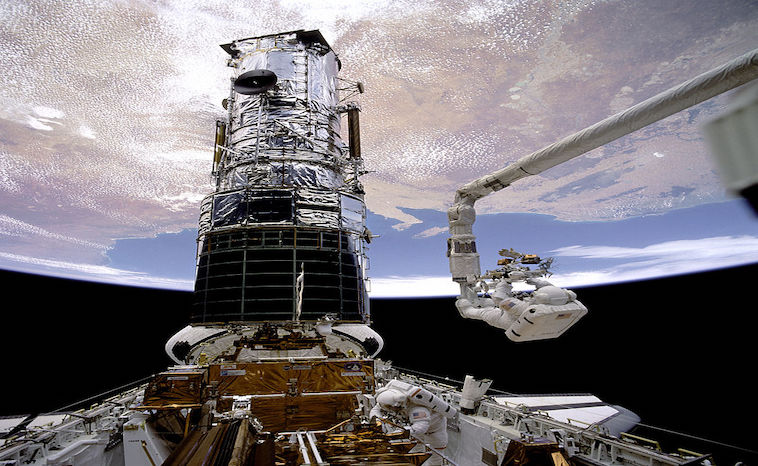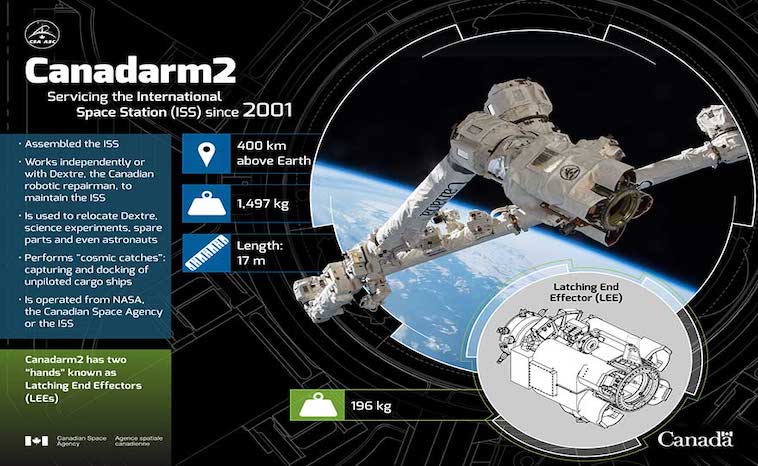NASA Robotic Arm Helping Astronauts

NASA uses a large robotic arm to help astronauts and scientists. Read on to learn more about these amazing robotic arms.
NASA uses robotic arms to help astronauts move large payloads in space. They are also used to grab moving objects like satellites and spacecraft. Since their development in the early 1980s, NASA has used the arms to several space shuttles and not uses one on the International Space Station. The Canadien Space Agency is responsible for the creation of the robotic arm. It is their contribution to the exploration of space.
NASA Robotic Arm
The original robotic arm called Canadarm was able to deploy and retrieve payloads weighing up to 733 pounds in space. By the mid-1990s, NASA redesigned the arm to increase its payload capability to 7,260 pounds. This was done to support the assembly of the International Space Station. In order to control the arm, astronauts use two hand controllers. One astronaut controls the arm from the rear deck control system and the other astronaut assists by using a television camera.
In 1984, the Space Shuttle Challenger used Canadarm to capture a broken satellite. Astronaut George D. Nelson was unable to grab the satellite by hand. Later Mr. Nelson and astronaut James van Hoften used the Shuttle’s giant arm to grab the satellite. Once they grabbed onto the satellite, both men worked on the repair and sent it back into orbit around the Earth.

NASA, Public domain, via Wikimedia Commons
Robotic Arm and HubbleCANADARM FAST FACTS
- 15.2 M (50 feet) long and 38 cm (15 inches) in diameter
- Six degrees of freedom
- Weighs: 410 kg (900 lb)
- Six joints which correspond to the joints of a human arm.
- End Effector- is the unit at the end of the wrist that grapples the payload.
- Two boom segments: Upper boom connects the shoulder and elbow. Lower boom connects the elbow and wrist joints.
- Flew 90 missions and completed its last mission in July 2011.

Credit: CSA
Credit: CSACanadarm 2
The International Space Station (ISS) has a second NASA robotic arm called Canadarm 2. It was developed to help build the ISS. Canadarm 2 can catch cargo ships as they dock on the ISS and bring supplies. Second, it can move equipment and supplies around the space station. Third, it can hold astronauts as they work on the ISS. The arm extends 58 feet and is 14 inches in diameter. The arm weighs 4,000 pounds and is made from titanium.
How does it make a cosmic catch?
- ApproachWith the help of GPS technology and a laser navigation system, the cargo ship slowly approaches the Station. Once the ship is approximately 500 meters below them, the Space Station crew begins to monitor its progress to ensure a safe approach. The visiting ship then moves closer by occasionally firing its thrusters.
- AlignmentThe guidance and control system synchronizes the vehicle’s movements with those of the Station. The two spacecraft fly in formation at an altitude of approximately 400 km above Earth and a speed of about 28,000 km/h.
- Catching and berthingAn astronaut on board the ISS extends Canadarm2 and catches the ship. Once it has been caught, the crew collaborates with the ground team to berth it to one of the Station’s ports.
- UnloadingThe astronauts then open the airlocks between the Station and the ship and unload the contents. Dextre can also help unload bigger, bulkier items from the “
trunk
” of some of these vehicles, especially the HTV. Cargo ships can remain docked to the ISS for up to a month. - ReturnOnce the mission is complete, the vehicle is released from the Station. (Credit: Canadien Space Agency)
Robotic Arms Future
The robotic arm has gone many transformations over the years. New parts are constantly being added by other nations, including Japan and Europe. What will happen to the arm once the ISS shuts down no one knows. For now, we will enjoy seeing the robotic arm capture spacecraft and moving payloads onboard the ISS.
